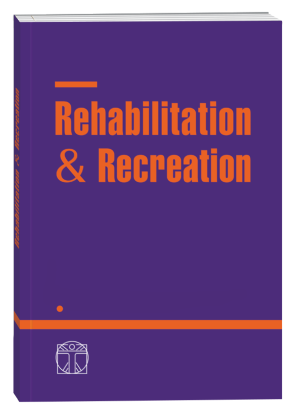DISTINCTIVE FEATURES OF SOMATOMETRICAL INDICATORS OF WOMEN IN THE FIRST PERIOD OF MATURE AGE
DOI:
https://doi.org/10.32782/2522-1795.2024.18.4.12Keywords:
mature age, women, physical development, somatometric signs of morphological status, posture, health fitnessAbstract
A systematic analysis of the world body of scientific knowledge and international experience in the advancement of biomechanics of the spatial organization of the human body indicates certain theoretical and practical developments in the field of this scientific direction. Despite the fact that in foreign scientific schools, the problems of biomechanics of the spatial organization of the human body have been studied much longer, national authors have made a number of successful attempts to study the biomechanics of posture recently. The research aim was to determine the differences in the somatometric characteristics of women aged 23–25 and 26–27 with different types of posture. Research methods: theoretical analysis and generalization of literary sources; anthropometry, pedagogical experiment, photography and posture analysis, methods of mathematical statistics. The results. It was determined that postural disorders, particularly scoliotic posture, can affect chest proportionality, possibly through changes in the position or structure of the chest. This can have consequences not only for the aesthetic perception, but also for the functional characteristics of the chest (for example, for respiratory function). The absence of significant differences for other indices suggests that these parameters are less prone to changes depending on the type of posture, associated with stable anatomical features that vary slightly depending on the posture and can be relied on as stable indicators of body condition. Thus, a comparative analysis of body circumference indices of women in the first period of adulthood revealed a pattern associated with increasing age, namely, a tendency to increase waist circumference and decrease its proportionality to height. Conclusions. Regularities related to the type of posture were revealed. They are: women with scoliotic posture showed a tendency to the worst ratio of anthropometric parameters, which was expressed in the smallest girth of the shins with rather large, compared to the rest of the groups, indices of Quetelet, Rohrer and chest girth, which evidences an uneven muscle development, typical of scoliosis, where the curvature of the spine leads to an asymmetric load on the muscles, reducing their mass and tone on a certain side of the body.
References
1. Hakman A., Andrieieva O., Kashuba V., Nakonechnyi I., Cherednichenko S., Khrypko I., Tomilina Yu., Filak, F. (2020). Characteristics of Biogeometric Profile of Posture and Quality of Life of Students During the Process of Physical Education. Journal of Physical Education and Sport. 20(1):79–85. https://doi.org/10.7752/jpes.2020.01010
2. Grygus I., Rebrov V., Gamma T. (2021). Features of postural disorders and motivational priorities regarding health activities of women of the first period of adulthood. Journal of Education, Health and Sport. 11(2):357–372. http://dx.doi.org/10.12775/JEHS.2021.11.02.033https://apcz.umk.pl/JEHS/article/view/55540 https://zenodo.org/records/13899817
3. Grygus I., Rebrov V., Orel I. (2022). Features of the socio-pedagogical profile of women of the first period of adulthood engaged in health fitness. Journal of Education, Health and Sport. 12(3):356–366. http://dx.doi.org/10.12775/JEHS.2022.12.03.032
4. Grygus I., Dolishnyi M., Rebrov V. (2024). Goniometric body profile of men 26–31 years old engaged in health-improving fitness. Physical rehabilitation and recreational health technologies. 9(5):362–369. https://doi.org/10.15391/prrht.2024-9(5).03
5. Kashuba V., Rudenko Y., Khabynets T., Nosova N. (2020). Use of correctional technologies in the process of health-recreational fitness training by men with impaired biogeometric profile of posture. Pedagogy and Psychology of Sport. 6(4):45–55. http://dx.doi.org/10.12775/PPS.2020.06.04.005
6. Kashuba V., Samoiluk O., Usychenko V., Lopatskyi S., Krykun Y. (2024). Distinctive features of somatometric indicators of women of the first period of mature age with different types of posture. Fizicna Reabilitacia ta Rekreacijno-Ozdorovci Tehnologii / Physical rehabilitation and recreational health technologies. 9(5):352–361. https://doi.org/10.15391/prrht.2024-9(5).02
7. Kashuba V., Khmelnitska I., Andrieieva O. et al. (2021). Biogeometric Profile of the Posture as a Factor of Men’s Functional Assessment of Movements in the Early Middle Age. Sport Mont. 19(2):35–39. DOI 10.26773/smj.210907
8. Matiichuk V.I., Grygus I.M., Kashuba V.O. (2024). Postural control of student of different body types methods of students rehabilitation of military personnel, status. Rehabilitation & Recreation. 18(1):70–77. https://doi.org/10.32782/2522-1795.2024.18.8
Downloads
Published
How to Cite
Issue
Section
License

This work is licensed under a Creative Commons Attribution-NonCommercial-NoDerivatives 4.0 International License.












